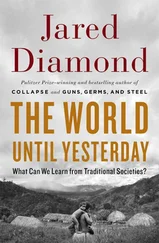Jared Diamond - Guns, Germs & Steel
Здесь есть возможность читать онлайн «Jared Diamond - Guns, Germs & Steel» весь текст электронной книги совершенно бесплатно (целиком полную версию без сокращений). В некоторых случаях можно слушать аудио, скачать через торрент в формате fb2 и присутствует краткое содержание. Жанр: 105. Описание произведения, (предисловие) а так же отзывы посетителей доступны на портале библиотеки ЛибКат.
- Название:Guns, Germs & Steel
- Автор:
- Жанр:
- Год:неизвестен
- ISBN:нет данных
- Рейтинг книги:5 / 5. Голосов: 1
-
Избранное:Добавить в избранное
- Отзывы:
-
Ваша оценка:
- 100
- 1
- 2
- 3
- 4
- 5
Guns, Germs & Steel: краткое содержание, описание и аннотация
Предлагаем к чтению аннотацию, описание, краткое содержание или предисловие (зависит от того, что написал сам автор книги «Guns, Germs & Steel»). Если вы не нашли необходимую информацию о книге — напишите в комментариях, мы постараемся отыскать её.
Guns, Germs & Steel — читать онлайн бесплатно полную книгу (весь текст) целиком
Ниже представлен текст книги, разбитый по страницам. Система сохранения места последней прочитанной страницы, позволяет с удобством читать онлайн бесплатно книгу «Guns, Germs & Steel», без необходимости каждый раз заново искать на чём Вы остановились. Поставьте закладку, и сможете в любой момент перейти на страницу, на которой закончили чтение.
Интервал:
Закладка:
figure 19.4. Approximate paths of the expansion that carried people speaking Bantu languages, originating from a homeland (designated H) 'n the northwest comer of the current Bantu area, over eastern and south ern Africa between 3000 b.c. and a.d. 500.
3 9 6 • GUNS, GERMS,and steel
compete against numerous Nilo-Saharan and Afroasiatic Iron Age farmers. But to the south lay 2,000 miles of country thinly occupied by Khoisan hunter-gatherers, lacking iron and crops. Within a few centuries, in one of the swiftest colonizing advances of recent prehistory, Bantu farmers had swept all the way to Natal, on the east coast of what is now South Africa.
It's easy to oversimplify what was undoubtedly a rapid and dramatic expansion, and to picture all Khoisan in the way being trampled by onrushing Bantu hordes. In reality, things were more complicated. Khoisan peoples of southern Africa had already acquired sheep and cattle a few centuries ahead of the Bantu advance. The first Bantu pioneers probably were few in number, selected wet-forest areas suitable for their yam agriculture, and leapfrogged over drier areas, which they left to Khoisan herders and hunter-gatherers. Trading and marriage relationships were undoubtedly established between those Khoisan and the Bantu farmers, each occupying different adjacent habitats, just as Pygmy hunter-gatherers and Bantu farmers still do today in equatorial Africa. Only gradually, as the Bantu multiplied and incorporated cattle and dry-climate cereals into their economy, did they fill in the leapfrogged areas. But the eventual result was still the same: Bantu farmers occupying most of the former Khoisan realm; the legacy of those former Khoisan inhabitants reduced to clicks in scattered non-Khoisan languages, as well as buried skulls and stone tools waiting for archaeologists to discover; and the Khoisan-like appearance of some southern African Bantu peoples.
What actually happened to all those vanished Khoisan populations? We don't know. All we can say for sure is that, in places where Khoisan peoples had lived for perhaps tens of thousands of years, there are now Bantu. We can only venture a guess, by analogy with witnessed events in modern times when steel-toting white farmers collided with stone tool-using hunter-gatherers of Aboriginal Australia and Indian California. There, we know that hunter-gatherers were rapidly eliminated in a combination of ways: they were driven out, men were killed or enslaved, women were appropriated as wives, and both sexes became infected with epidemics of the farmers' diseases. An example of such a disease in Africa is malaria, which is borne by mosquitoes that breed around farmers' villages, and to which the invading Bantu had already developed genetic resistance but Khoisan hunter-gatherers probably had not.
However, Figure 19.1, of recent African human distributions, reminds us that the Bantu did not overrun all the Khoisan, who did survive in
HOW AFRICA BECAME BLACK • 397
southern African areas unsuitable for Bantu agriculture. The southernmost Bantu people, the Xhosa, stopped at the Fish River on South Africa's south coast, 500 miles east of Cape Town. It's not that the Cape of Good Hope itself is too dry for agriculture: it is, after all, the breadbasket of modern South Africa. Instead, the Cape has a Mediterranean climate of winter rains, in which the Bantu summer-rain crops do not grow. By 1652, the year the Dutch arrived at Cape Town with their winter-rain crops of Near Eastern origin, the Xhosa had still not spread beyond the Fish River.
That seeming detail of plant geography had enormous implications for politics today. One consequence was that, once South African whites had quickly killed or infected or driven off the Cape's Khoisan population, whites could claim correctly that they had occupied the Cape before the Bantu and thus had prior rights to it. That claim needn't be taken seriously, since the prior rights of the Cape Khoisan didn't inhibit whites from dispossessing them. The much heavier consequence was that the Dutch settlers in 1652 had to contend only with a sparse population of Khoisan herders, not with a dense population of steel-equipped Bantu farmers. When whites finally spread east to encounter the Xhosa at the Fish River in 1702, a period of desperate fighting began. Even though Europeans by then could supply troops from their secure base at the Cape, it took nine wars and 175 years for their armies, advancing at an average rate of less than one mile per year, to subdue the Xhosa. How could whites have succeeded in establishing themselves at the Cape at all, if those first few arriving Dutch ships had faced such fierce resistance?
Thus, the problems of modern South Africa stem at least in part from a geographic accident. The homeland of the Cape Khoisan happened to contain few wild plants suitable for domestication; the Bantu happened to inherit summer-rain crops from their ancestors of 5,000 years ago; and Europeans happened to inherit winter-rain crops from their ancestors of nearly 10,000 years ago. Just as the sign "Goering Street" in the capital of newly independent Namibia reminded me, Africa's past has stamped itself deeply on Africa's present.
That's how the Bantu were able to engulf the Khoisan, instead of vice versa. Now let's turn to the remaining question in our puzzle of African prehistory: why Europeans were the ones to colonize sub-Saharan Africa. That it was not the other way around is especially surprising, because
398 • GUNS, GERMS, ANDsteel
Africa was the sole cradle of human evolution for millions of years, as well as perhaps the homeland of anatomically modern Homo sapiens. To these advantages of Africa's enormous head start were added those of highly diverse climates and habitats and of the world's highest human diversity. An extraterrestrial visiting Earth 10,000 years ago might have been forgiven for predicting that Europe would end up as a set of vassal states of a sub-Saharan African empire.
The proximate reasons behind the outcome of Africa's collision with Europe are clear. Just as in their encounter with Native Americans, Europeans entering Africa enjoyed the triple advantage of guns and other technology, widespread literacy, and the political organization necessary to sustain expensive programs of exploration and conquest. Those advantages manifested themselves almost as soon as the collisions started: barely four years after Vasco da Gama first reached the East African coast, in 1498, he returned with a fleet bristling with cannons to compel the surrender of East Africa's most important port, Kilwa, which controlled the Zimbabwe gold trade. But why did Europeans develop those three advantages before sub-Saharan Africans could?
As we have discussed, all three arose historically from the development of food production. But food production was delayed in sub-Saharan Africa (compared with Eurasia) by Africa's paucity of domesticable native animal and plant species, its much smaller area suitable for indigenous food production, and its north-south axis, which retarded the spread of food production and inventions. Let's examine how those factors operated.
First, as regards domestic animals, we've already seen that those of sub-Saharan Africa came from Eurasia, with the possible exception of a few from North Africa. As a result, domestic animals did not reach sub-Saharan Africa until thousands of years after they began to be utilized by emerging Eurasian civilizations. That's initially surprising, because we think of Africa as the continent of big wild mammals. But we saw in Chapter 9 that a wild animal, to be domesticated, must be sufficiently docile, submissive to humans, cheap to feed, and immune to diseases and must grow rapidly and breed well in captivity. Eurasia's native cows, sheep, goats, horses, and pigs were among the world's few large wild animal species to pass all those tests. Their African equivalents—such as the African buffalo, zebra, bush pig, rhino, and hippopotamus—have never been domesticated, not even in modern times.
Интервал:
Закладка:
Похожие книги на «Guns, Germs & Steel»
Представляем Вашему вниманию похожие книги на «Guns, Germs & Steel» списком для выбора. Мы отобрали схожую по названию и смыслу литературу в надежде предоставить читателям больше вариантов отыскать новые, интересные, ещё непрочитанные произведения.
Обсуждение, отзывы о книге «Guns, Germs & Steel» и просто собственные мнения читателей. Оставьте ваши комментарии, напишите, что Вы думаете о произведении, его смысле или главных героях. Укажите что конкретно понравилось, а что нет, и почему Вы так считаете.










